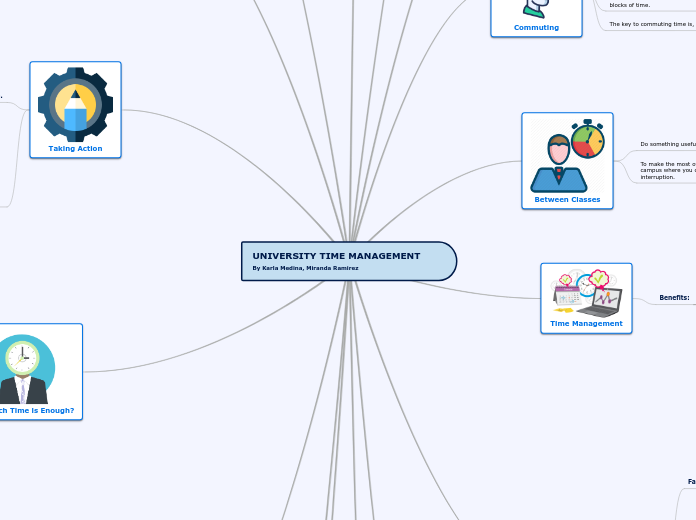UNIVERSITY TIME MANAGEMENT By Karla Medina, Miranda Ramirez

Motivation
Sometimes you just don't feel motivated to do your school work.
Motivation isn't a prerequisite to action…it is a result of it!
Substantial motivation problems
It might help to realize that when you aren't motivated to do school work
Sometimes it does not mean that you are not motivated but that your motivation is focused on another activity.

Line-ups
Sometimes as students we spend a lot of time waiting to do certain things.
It is important to use that waiting time to perform certain activities that are productive for school achievement.
Commuting
North Americans spend between 1 and 2 hours commuting from home to work or school every day.
The challenge is to use that time for something productive.
You will be amazed at how much you can learn in these small blocks of time.
The key to commuting time is, simply, use it or lose it.
Between Classes
Do something useful with the time.
To make the most of the time between classes, find a spot on campus where you can work comfortably and without interruption.

Time Management
Benefits:
1. Be successful.
2. Improve grades.
3. Keep stress in check.
4. Be competitive in the career you undertake following your university education.

The Time Management Cycle

Failed time management "systems"
They are born of perfectionism and unrealistic expectations.
Cyclical System
Phase 1: the process of goal setting to establish a context for managing time.
Phase 2: tracking time and developing an awareness for where you spend your time.
Phase 3: plan making.
- To-do lists
- Weekly plans
- Monthly plans
- Longer-range plans
Phase 4: self-monitoring your action.
Paying attention:
- How well you are working your plan
- How accurately you have planned
- How well you have forecasted for various events
Phase 5: shifting and adjusting.
Adjust and change the time in which corrections are made in the system before starting the cycle again in setting objectives.
Result: initialize a process of gradual, performance-based improvement in time management skill.

Goal Setting

It might help to divide your goals into time frames:
Immediate goals
Short-mid-term goals
Long-range goals

There are some questions that help you achieve your goals:
How many of the tasks you intend to do today contribute to accomplishing the goals you have set for yourself?
Are you actively working on these goals?
Are you putting any of them off for a later time?
What would you have to change in your life to make it possible to work on these goals?
Sub-dividing Goals into Manageable Pieces
Decomposing your goals makes it possible to tackle them one small step at a time and to reduce procrastination.
Seeing these connections can help you monitor your own progress and detect whether you are on track or not.
University Time Management

Getting Started
It can be difficult to start working.
Most of the time, however, not starting seems to be related to fear of poor results or negative evaluations than it is to the actual difficulty of the work.
Steps
1. Aim to subdivide tasks into small steps
2. Convince yourself that to get started all you need is 10 full minutes working on a task.

Procrastination
It often emerges as a means of distancing oneself from stressful activities.
People allocate more time to the judged-easy task than to judged-difficult tasks.
Dealing with the underlying stressful aspects of the activities can assist in reducing the extent of procrastination.

Time Shifting and Adjusting
Inevitably, you will need to make adjustments to your plans and your time management habits.
Time Troubles
Uncontrollable
Keep your cool and get back on track as soon as possible.
Unpredictable
Controllable
Deal with them directly and forcefully so that they don't prevent you from achieving your goals.
Predictable

Taking Action

The next step is to take action.

Now you must do the tasks that converge on your goals.
As you begin working on the tasks, keep your focus on doing the best you can to execute what you have set out for yourself.
Stay very clear on the fact that the plan is an ideal and that in action you will not execute it perfectly.
The main thing is to do the very best you can to follow the plan and monitor your progress so that you can learn from your good and bad experiences along the way.

How Much Time is Enough?
The time you spend on task has some relationship to the quality of work you end up producing.
What is important is that you spend enough time on school work to ensure that you're successful and that you spend enough time outside of school to ensure that you have a healthy balance in your life.
Keep your focus not on making the perfect plan or on executing every plan flawlessly, but on learning from your good and bad experiences and using this knowledge to improve subsequent plans.

Planning
The Monthly Planner
Uses:
- As a time-bound memory aid, tracking major deadlines and important dates.
- To record interim deadlines and forecast upcoming busy periods as final deadlines approach.
A properly completed monthly planner:
- Indicate upcoming busy periods.
- Show whether there is room in the plan for new tasks.
- Help you assess whether you are on target to achieve your goals.
Weekly Objectives List
It is a to-do list with additional features to further decompose tasks into smaller units and to record time estimates for the task.
The Weekly Planner
Stepping from the weekly objectives list to the weekly planner is easy.
Step 1: use time estimates for activities in the weekly list of objectives as guides, find an appropriate block of time in your schedule.
Step 2: write in the activities one at a time in priority order until you have either scheduled all of your activities or you have run out of time spaces.
Tips:
- Construct a plan for each week, following the rhythm of your courses that meet weekly.
- To help make planning a routine activity, pick a regular day each week to schedule.
Planned week:
- You will experience clarity of focus.
- Your tendency to be distracted will be reduced.
- You will be certain of your reasons for doing the things you had planned.

Time Awareness and Time Tracking
The process is to do as a schedule but it is not used the same.
Instead of writing things in that you are planning to do, time logging is a process of writing down the things that you have already done
A few ways to track your time follow:
Strategy 1
At the end of every hour jot yourself a quick note about how you actually spent your time for that hour.
Strategy 2
Some people find it helpful to modify the planning page to facilitate tracking time. The modifications are easy enough: make two columns on your paper for each day of the week
Strategy 3
Summarizing your time use by time category such as: sleep, study, work, travel and so onsummarize your time use by time category such as: sleep, study, work, travel and so on.
It will help you manage your time well if you know where your time actually gets spent.
Having accurate information about your time usage patterns can serve as another important point of reference for self-monitoring.
